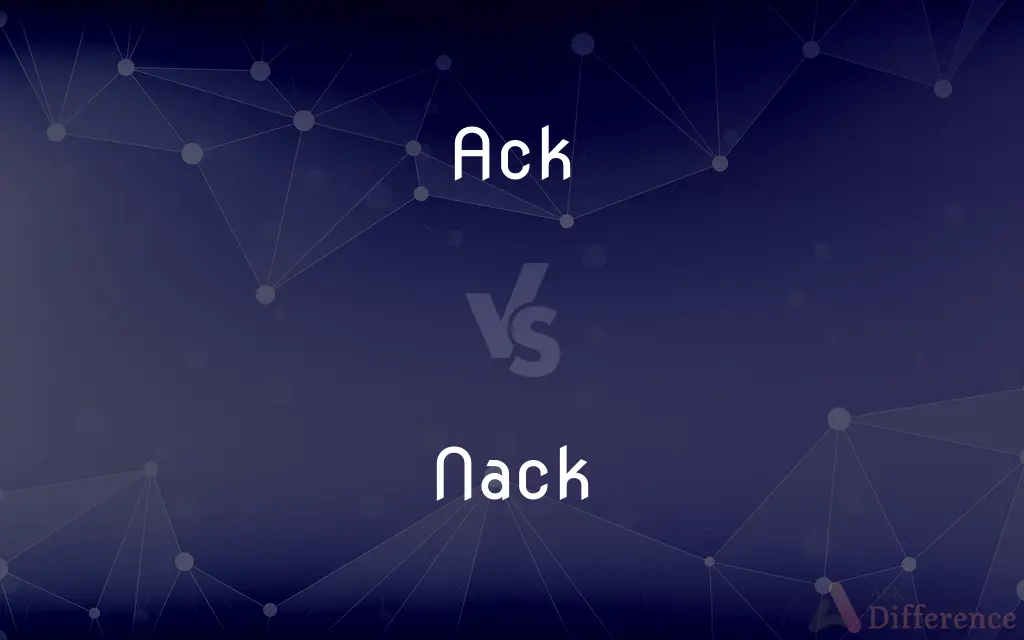Ack vs. Nack — What's the Difference?
Edited by Tayyaba Rehman — By Urooj Arif — Updated on April 8, 2024
ACK (Acknowledgment) signals the successful receipt of a message, while NACK (Negative Acknowledgment) indicates a problem or failure in receiving a message.

Difference Between Ack and Nack
Table of Contents
ADVERTISEMENT
Key Differences
ACK, short for Acknowledgment, is used in digital communications to signify that a message or data packet has been received successfully. This confirmation is crucial in ensuring data integrity and reliability in communication protocols. NACK, or Negative Acknowledgment, on the other hand, is sent to indicate that a message was not properly received, prompting the sender to resend the data. This mechanism helps in maintaining communication quality despite errors.
While ACK messages are a positive response from a receiver to a sender, confirming the successful delivery of data, NACK messages serve as alerts. They signal that the transmission was unsuccessful, due to reasons like data corruption or loss. This distinction helps in optimizing data transmission processes, ensuring efficient communication.
The use of ACK in communication protocols enables the establishment of a reliable data transfer mechanism, where the sender waits for an acknowledgment before proceeding with further transmissions. Conversely, the presence of NACK allows for error detection and correction, making it possible to recover from transmission errors without compromising the data integrity.
In protocols where ACK is used, there's often a timeout mechanism. If an ACK is not received within a certain timeframe, the data is resent. NACK messages, however, directly prompt a resend, making them integral to protocols that prioritize error correction and data accuracy.
The choice between using ACK and NACK in a communication system depends on the specific requirements of the data transfer process. While ACK is suited for environments where data integrity can be assumed or minor errors are tolerable, NACK is crucial in systems where accuracy is paramount, and every bit of data must be correctly received.
ADVERTISEMENT
Comparison Chart
Definition
Signal for successful data receipt
Signal for unsuccessful data receipt
Role in Communication
Confirms data integrity
Indicates data integrity issues
Impact on Data Transfer
Promotes continuation of data transmission
Triggers retransmission of data
Usage Context
Used in reliable transmission protocols
Used in error detection and correction
Communication Outcome
Positive acknowledgment
Negative acknowledgment
Compare with Definitions
Ack
Prompts continuation of data transmission.
Upon receiving an ACK, a device sends the next packet.
Nack
Triggers retransmission of data.
Following a NACK, a message is resent until correctly received.
Ack
Used in protocols for reliable transmission.
TCP protocol utilizes ACK for ensuring data delivery.
Nack
Indicates a problem in message reception.
A device sends a NACK in response to a corrupted packet.
Ack
Confirmation of successful message receipt.
A server sends an ACK after receiving a client's data packet.
Nack
Negative acknowledgment in communication.
A failed file download prompts a NACK signal.
Ack
Positive response in data exchange.
A text message is marked as 'Read' after an ACK is received.
Nack
Used where accuracy is critical.
In financial transactions, a NACK would prompt immediate correction.
Ack
Indicates data integrity in communication.
A file transfer completion is confirmed with an ACK signal.
Nack
Essential for error correction.
In digital TV broadcasting, NACKs ensure clear reception.
Ack
The letter A as used in signalling and other types of communications.
Nack
Nack is an Ortsgemeinde – a municipality belonging to a Verbandsgemeinde, a kind of collective municipality – in the Alzey-Worms district in Rhineland-Palatinate, Germany.
Ack
(data communications) acknowledgment signal
Nack
(networking) To acknowledge negatively; to send a NAK signal to.
Ack
Alt form of ACK.
Ack
(radio communications) acknowledged
Ack
Expressing distaste, alarm, or trepidation.
Common Curiosities
How does ACK improve communication?
ACK improves communication by ensuring data integrity, confirming to the sender that the data has been successfully received.
What happens if an ACK is not received?
If an ACK is not received, the sender typically resends the data, assuming it was lost or corrupted during transmission.
In which scenario is NACK particularly useful?
NACK is particularly useful in scenarios where data accuracy is critical, and any loss or corruption must be corrected.
Do all communication protocols use ACK and NACK?
Not all, but many reliable communication protocols use ACK and NACK to ensure data integrity and correct transmission errors.
How do ACK and NACK contribute to data integrity?
ACK confirms the correct receipt of data, while NACK alerts to errors, together ensuring data integrity through error detection and correction.
What does ACK stand for?
ACK stands for Acknowledgment, indicating successful data receipt in communications.
Can a communication protocol use both ACK and NACK?
Yes, a communication protocol can use both ACK and NACK to efficiently manage data transmissions and error corrections.
Is NACK always a negative outcome?
While NACK indicates a problem, it's not always negative; it's a necessary mechanism for error correction in reliable communications.
How do ACK and NACK affect data transfer speed?
While ACKs facilitate smooth data flow, NACKs can slow down transfer speeds due to the need for retransmissions.
What is the purpose of a NACK message?
The purpose of a NACK message is to indicate a failure in receiving data correctly, prompting a retransmission.
What is a typical response to receiving a NACK?
The typical response to receiving a NACK is to resend the affected data packet or message to correct the transmission error.
Is there a scenario where NACK is preferred over ACK?
NACK is preferred in systems where error detection and immediate correction are prioritized over continuous data flow.
Can the absence of an ACK serve as a NACK?
In some protocols, the absence of an ACK within a certain timeframe implicitly serves as a NACK, prompting data retransmission.
What is the significance of ACK and NACK in TCP/IP?
In TCP/IP, ACK and NACK play crucial roles in ensuring reliable data transmission over the internet, handling data integrity and error correction.
How do timeouts relate to ACK and NACK messages?
Timeouts are often used to trigger actions (like resending data) when an ACK is not received, while a NACK immediately indicates an issue.
Share Your Discovery

Previous Comparison
Slab vs. Plate
Next Comparison
Circumstance vs. CoincidenceAuthor Spotlight
Written by
Urooj ArifUrooj is a skilled content writer at Ask Difference, known for her exceptional ability to simplify complex topics into engaging and informative content. With a passion for research and a flair for clear, concise writing, she consistently delivers articles that resonate with our diverse audience.
Edited by
Tayyaba RehmanTayyaba Rehman is a distinguished writer, currently serving as a primary contributor to askdifference.com. As a researcher in semantics and etymology, Tayyaba's passion for the complexity of languages and their distinctions has found a perfect home on the platform. Tayyaba delves into the intricacies of language, distinguishing between commonly confused words and phrases, thereby providing clarity for readers worldwide.














































